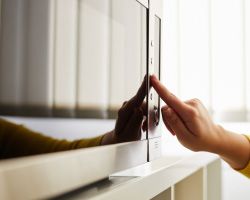Health library
Back to health libraryHot tips for safe microwave use

Simple rules for safe heating.
Percy Spencer was saving his chocolate bar for a snack.
But it was not meant to be.
Spencer, an engineer, stopped briefly in front of a magnetron—a radio-wave device—and, to his surprise, the chocolate bar in his pocket quickly melted.
Curious, Spencer placed popcorn kernels near the magnetron. Soon crispy puffs were popping onto the floor.
Spencer put a raw egg in a pot near the magnetron. The egg exploded, splattering a nearby co-worker.
Spencer's messy food experiments led to an important discovery: cooking with microwaves—very-high-frequency radio waves that can quickly and conveniently heat food.
Using that principle, Spencer helped develop the first radar range—or microwave, as we now call it—which weighed a whopping 750 pounds and stood nearly 6 feet tall.
That was more than 70 years ago. Today, microwaves easily fit into the kitchens—and busy lifestyles—of millions of households around the world.
Behind the buttons
In a matter of minutes—even seconds—food can go from ice cold to piping hot in a microwave.
Here's how it works: A small tube, the magnetron, produces microwaves. The waves bounce around in the metal interior of the oven and are absorbed by food.
The microwaves cause water molecules in the food to vibrate, producing heat that cooks the food. That's why foods such as fresh vegetables, which have a high water content, can be microwaved more quickly than other foods.
Benefits and risks
According to the U.S. Food and Drug Administration, microwave cooking does not reduce the nutritional value of foods any more than conventional cooking methods. In fact, foods cooked in a microwave may retain more of their vitamins and minerals because the foods can cook more quickly and without adding water.
Microwave cooking can also be more energy efficient because only the food heats up, not the entire oven compartment.
Although microwave cooking can be quick and convenient, it can also carry some risks, including foodborne illnesses, burns and fires.
To help avoid these dangers, follow the manufacturer's instructions on how to use your microwave safely and properly. And take these precautions:
Choose safe containers and wraps
- Use glass, ceramic or plastic containers that are approved for microwave use, the U.S. Department of Agriculture (USDA) recommends. If the container isn't labeled as microwave-safe, don't use it.
- Don't allow plastic wrap to touch food during microwaving. Plastic wrap contains chemicals that could be absorbed by the food. To minimize this risk, cover the dish loosely with the wrap and leave a corner turned back to let steam escape.
- Never use thin, plastic storage bags, brown paper bags, or plastic grocery bags, newspapers, aluminum foil or metal objects in the microwave. Metallic objects, twist ties and gold paint on dishes can cause electric sparks and possibly damage the oven, according to the USDA.
- Don't use plastic storage containers, such as margarine tubs, take-out containers or whipped topping bowls, in the microwave. They can warp or melt, possibly causing harmful chemicals to be absorbed by the food.
- Don't reuse containers from prepared, microwavable meals. They are intended for one-time use only.
Defrosting without danger
- Remove food from packaging before defrosting it in the microwave.
- Cook the food—especially meat, poultry, egg casseroles and fish—immediately after defrosting. Don't reserve partially cooked food to use later.
Cook and reheat with care
- Cover foods with a lid or a microwave-safe plastic wrap to hold in moisture and provide safe, even heating. Cooking bags are also safe.
- Stir or rotate the dish several times during cooking to help ensure uniform heating and eliminate cold spots where harmful bacteria can survive.
- When cooking large cuts of meat, use medium power and cook the meat for longer than you would using high heat. This allows heat to reach the center without overcooking outer areas.
- Heat ready-to-eat foods like hot dogs, luncheon meats and leftovers until steaming.
- Don't microwave water or liquids for excessive amounts of time. People have suffered serious burns and scalds around their hands and faces from water that has been overheated in a microwave. This superheated water doesn't appear to be boiling, but even a slight movement—such as lifting the cup or adding a teaspoon of sugar—can cause a violent eruption of the water.
- Use potholders to remove heated food from the microwave.
- After microwaving food, open containers slowly and point them away from your face. Containers may feel warm, but the contents could be very hot.
- Stir heated food before tasting. This helps eliminate hot spots that can cause burns.
Prevent fires
- Plug the microwave directly into an outlet, the National Fire Protection Association says. Never use an extension cord; it could overload the circuit and cause a fire.
- If a fire starts in your microwave, keep the door closed and unplug it. Don't open the door until the fire is completely out. If in doubt, leave the house and call the fire department. Have the microwave serviced before using it again.
Reviewed 11/20/2025
